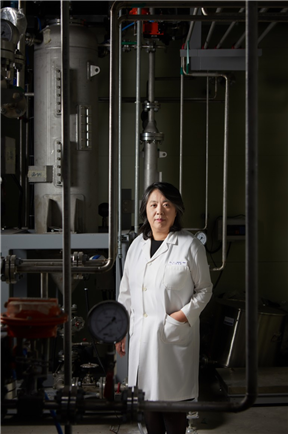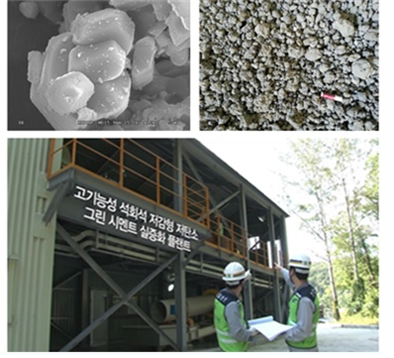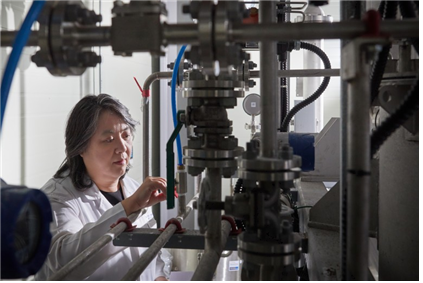- Name담당자-MOU
- Date2021/12/17 00:00
- Hit990
Saving The Earth Projects: Carbon Neutrality Strategy I
‘Carbon Mineralization in Industry by KIGAM’
Since the COVID-19, the seriousness of the global climate issues has become more prominent. Major countries around the world declared ‘Carbon Neutrality’ to enter a new climate regime for the earth’s future fate.
In line with this grand gesture, Korea also confirmed and announced the ‘2050 Carbon Neutrality Strategy’ and initiated to start a full-scale carbon reduction. The KIGAM’s Center for Carbon Mineralization is in leading Korea’s greenhouse gas reduction by applying and demonstrating the world's best carbon mineralization technology.

○ The Birth of ‘Carbon Mineralization’
Dr. Ahn Ji-hwan, who majored in resource engineering, has pioneered the field of ‘Precipitated Calcium Carbonate’ in Korea for over 30 years. Like the expression she usually uses, “the total amount of life,” she thinks that her research life is also a scenario book. From her school days, when it was difficult to endure as the first female student in the field of resource engineering, to the moment when her research fate changed when she started her first consigned research project at POSCO with the benefit of the PBS (Program Based-Funding System) system, an opportunity came to her like fate at every desperate moment.
“In the early 2000s, there were very few studies on converting inorganic waste into resources in fields such as cement manufacturing.
Through the 21st Century Frontier Recycling Project, I have been conducting research step by step, such as equipping a precipitated calcium carbonate experiment equipment, and this field has turned into a full-fledged study.
Research on waste as a raw material for cement has led to the study of the current CO₂ mitigation model.” She applied the carbonation reaction to synthesize precipitated calcium carbonate in the process of treating heavy metals contained in waste. By applying this carbonation reaction, she researched a technology for recycling waste by utilizing CO₂, stabilizing heavy metals, and decomposing poorly soluble salts. However, looking at this technology from a different perspective, it was related to CCU (Carbon Capture Utilization) technology that utilizes CO₂. She says that the recycling of waste and the use of CO₂, which are the basics of the circular economy, are the result of the desperate research that has been carried out for a long time.
Four of Dr. Ahn’s flagship technologies for waste treatment with Carbon Dioxide were included in Korea’s 16 representative CO₂ reduction technologies for implementing the ‘Paris Climate Agreement.’ According to Dr. Ahn, she first proposed the term ‘Carbon Mineralization’ in early 2000 to the existing technology called ‘mineral carbonation’ with adding the wit of unique characteristics of KIGAM.

○ Carbon Reduction Technology recognized by the United Nations
After the Paris Agreement, the government established a 'carbon resource development strategy' to contribute to the reduction of national greenhouse gases and to create economic value at the same time. Dr. Ahn jointly with the Ministry of Science and ICT, the Ministry of Trade, Industry and Energy, and the Ministry of Environment, launched the ‘Carbon Mineral Flagship Project Group’ and is conducting a demonstration of carbon mineralization technology.
The Carbon Mineralization Flagship Center has been researching mineral carbonation of by-products from daily life and industry. Based on this, she plans to produce high value-added mineral products and secure new circulating resources by processing by-products at the same time as CO₂ mineralization. In addition, she aims to secure carbon credits in developing countries, etc. by researching and commercializing new Clean Development Mechanism (CDM) methods through standardization and regimentation of developed technologies by converting indigenous research result technologies into global greenhouse gas reduction technologies.
"The Carbon Minerals Flagship Center is contributing to the reduction of national greenhouse gas emissions by applying the world's best carbon mineralization technology.
Our goal is to create and lead a new global market by leaping forward as the world's No. 1 technology country for carbon resource conversion. In particular, we are concentrating on securing overseas carbon credits." The main projects are water-repellent cement production technology that can reduce CO₂, and technology development and demonstration that directly utilizes low-concentration CO₂. This method uses power generation ash, etc. to produce composit carbonate. This method uses power generation ash to produce complex carbonate, which can be applied to the existing industrial sites as well as new industries in the future.
A new methodology for reducing greenhouse gas, developed based on water-repellent cement production technology based on raw material mixing design technology, a source technology that can reduce CO₂, has been approved and announced in the United Nations Framework Convention on Climate Change (UNFCCC). The United Nations Framework Convention on Climate Change Clean Development Mechanism method prescribes (approves) standards for methods for estimating greenhouse gas reductions, and currently 220 cases have been approved. Based on the methodology developed by advanced countries, it is being used as a means to achieve greenhouse gas reduction goals in cooperation with developing countries.
This achievement means that the original technology developed in Korea has been recognized as an international greenhouse gas reduction technology. In addition, it can be expected to expand overseas reduction projects such as developing countries along with securing technological advantage in CO₂ reduction means.
The Carbon Minerals Flagship Center conducted a demonstration of a technology that directly utilizes low-concentration CO₂. Demonstration of a source technology that can reduce greenhouse gas emissions by using composit carbonate and water-repellent cement as a filler in abandoned mines is also in progress.

○ Early Education in Everyday Life for the Carbon Neutrality Efforts
To achieve ‘Carbon Neutrality, Dr. Ahn emphasizes that it is necessary to create a system to change people's awareness of the ‘waste recycling economy’ and to diversify a new model centering on ‘regional-based industries,’ saying “we need to create an education system to change into a low-carbon society throughout the region for a carbon-neutral society by establishing a circulation system that is the basis of carbon mineralization this year and implementing it to reduce carbon dioxide.”
Dr. Ahn Ji-hwan said that everyone's participation is important for ‘Carbon Neutrality.’ She said that reducing carbon dioxide must be a collective effort for societies as a whole. Furthermore, young school children should be familiar with the understanding of global warming and the greenhouse gas effect. Early education in carbon reduction can help to save the earth.
For More Information:
Dr. Ahn Ji-hwan
(E-Mail: ahnjw@kigam.re.kr)
Head, Center for Carbon Mineralization
Mineral Resources Division
Korea Institute of Geoscience and Mineral Resources (KIGAM)